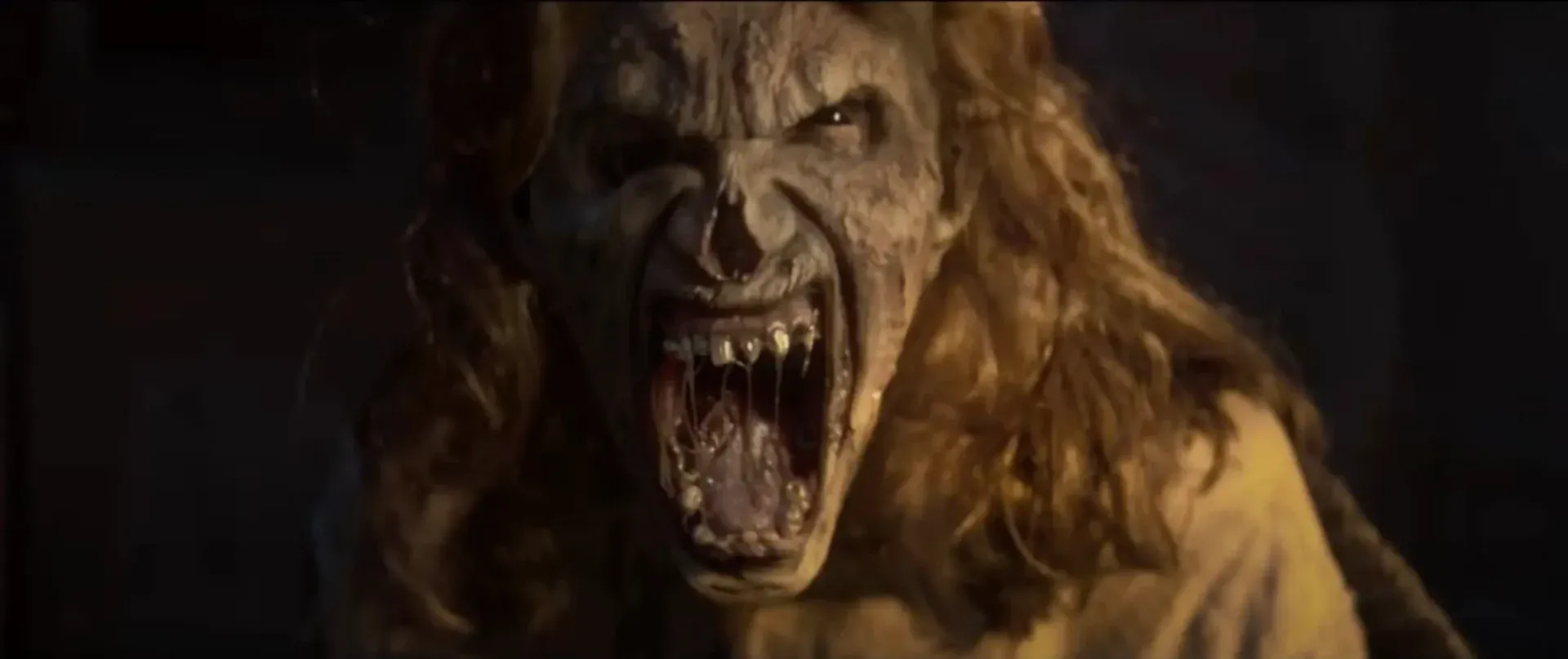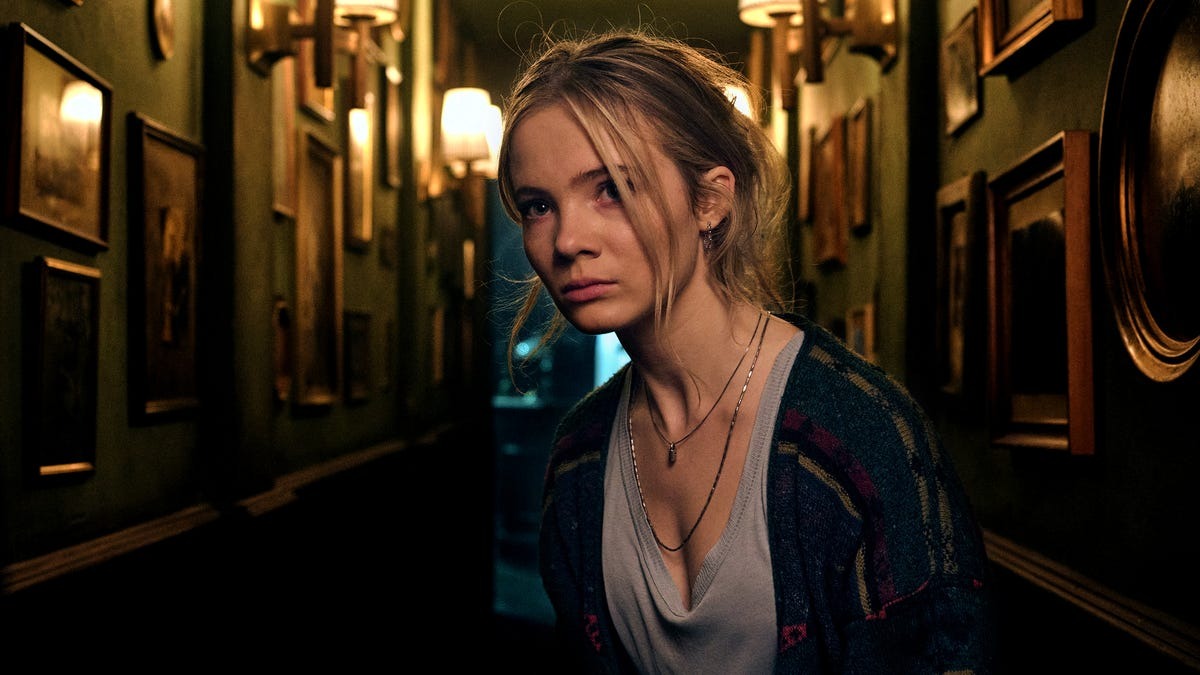Alberto Corredor’s Baghead, which is based on his 2017 short film, revolves around a pub located somewhere in Berlin called The Queen’s Head. The pub’s owner, Owen Lark, records a VHS tape, informing any prospective caretaker that they must take on the role of guarding a mysterious creature locked away in the basement.
The agreement states that the creature, Baghead, will be bound to the guardian for as long as they are alive, with Baghead trying to escape and the guardian tasked with preventing this. Meanwhile, a desperate individual wishes to meet Baghead, but Owen refuses him, as he plans to kill her by setting her on fire to end the curse.

This plan fails tragically when Owen himself burns to death. Iris, Owen’s estranged daughter, is notified of his death and travels to Berlin to identify his body and handle the pub, which she had no prior knowledge of. Upon arriving, the solicitor gives her a tour of the pub, urging her to settle matters as soon as possible.
Iris, however, decides to stay the night and wait for her lawyer friend, Katie, to arrive before addressing the legal matters. That evening, Neil, the man from earlier, returns, offering Iris a large sum of money to take him to Baghead. She tells him to return the next day.
Realizing she can profit from bringing people to the basement for a fright, Iris decides to keep the pub, which disappoints the solicitor.
Katie is opposed to Iris’s decision, citing the eerie atmosphere, but things take a dramatic turn when Neil summons Baghead, offers her jewelry (which she consumes), and briefly brings Neil’s mother, Regina, back from the dead, causing chaos.
This reveals that Baghead can channel the spirit of a loved one after consuming their item and use it to manipulate the person communicating with her. Baghead listens only to Iris, her guardian, although she can still manipulate her.
The entity is forbidden to leave the basement, and no one is allowed to enter the hole where she emerges. The central question of whether Iris will continue this nightmare or sell the pub forms the crux of the story.
The End Explained
If you’ve seen Talk to Me, you’ll notice some striking similarities between it and Baghead. Both films involve communicating with the dead through a malevolent force, dealing with the long-lasting impact of grief and trauma, a time limit, and, of course, an open ending where the evil finds a way to continue.
Despite my admiration for Talk to Me, Alberto Corredor’s short film dates back to 2017 or 2018, meaning the core concept was already in existence before Danny and Michael Philippou made their film. Talk to Me premiered at the Adelaide Film Festival in 2022, so the production likely took place between 2019 and 2021.
Whether it’s a case of two independent creators coming up with similar stories or the Philippous seeing Baghead and adapting it into Talk to Me, I can’t say for sure. However, it’s frustrating to see critics label Baghead as a mere imitation of Talk to Me, especially when the original idea predates the A24 film.
Yes, both movies feature updated takes on the Ouija board or mediums, but it’s clear that each film brings its unique approach. Given that Baghead was released after Talk to Me, many automatically assume it’s a copy, but I urge reviewers to do more research before making sweeping judgments.
As for the movie itself, Baghead presents a mix of great and not-so-great moments. Some parts are the work of someone brimming with creativity and visual ingenuity, while other sections feel lackluster and uninspired.
The film doesn’t entirely lose its energy as it moves from one act to the next, but there are noticeable highs and lows. The opening 15 minutes, for example, are compelling with match-cuts, clever use of the architecture, and an intriguing sense of curiosity.
The build-up to Baghead’s appearance is decent, and the use of minimal yet effective VFX and SFX to show Regina’s drowning is impressive. However, the movie becomes somewhat predictable until Neil’s second encounter with Baghead.
One particularly striking moment involves using blinking lights as the only light source in the basement—imagine how chilling that would be on the big screen. Iris’ visions are a highlight, especially the scene where Owen rips off his face to reveal the bag.
The film regains its strength with a split-diopter shot featuring Iris, Neil, and Baghead in the same frame. Although the film finishes strongly, the overall experience feels worthwhile. If Corredor had maintained a consistent level of ambition and visuals to emphasize the themes, the film might have been a standout.
Themes and Performances
On the thematic side, I appreciate how Baghead slowly evolves into a tale of feminine rage taking physical form. It suggests that even an ancient, slightly demonic entity is preferable to a man. The performances throughout are solid.

Freya Allan, known for her role in The Witcher series, continues to prove her talent and is set for a major role in Kingdom of the Planet of the Apes. It’s refreshing to see her star in a horror film like this amidst such heavy projects.
Ruby Barker, famous for Bridgerton, delivers a memorable performance, though her character deserved more. Jeremy Irvine plays Neil’s deceptive nature perfectly. Anne Muller, portraying Baghead, deserves recognition for her physically demanding role.
The cameos from Svenja Jung, Ned Dennehy, Julika Jenkins, and Saffron Burrows are noteworthy, but Peter Mullan truly steals the show. Despite limited screen time, Mullan injects Owen with profound grief, pain, and gravity, all conveyed through his deep, raspy voice.
If this piques your interest, I encourage you to check out Baghead. And, by all means, give Talk to Me a watch as well and compare the two films for yourself.



